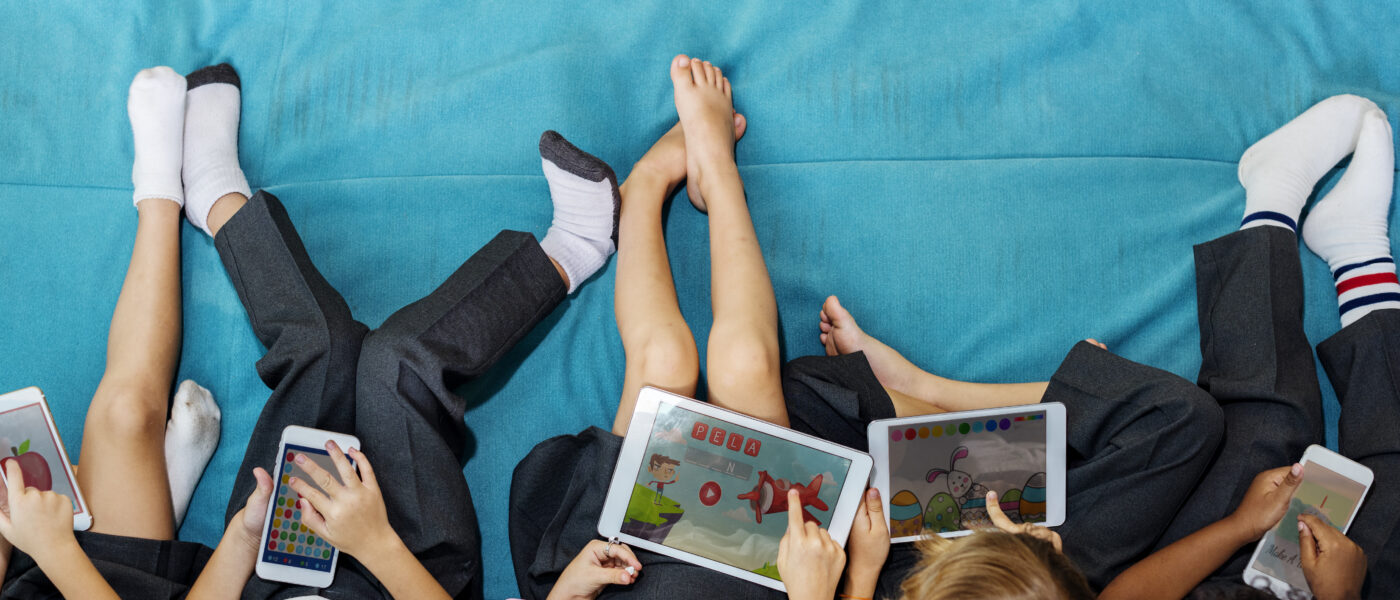Book Review: Mobile Lenses on Learning: Language and Literacies on the Move, by Mark Pegrum
By Andrew Walton, University of Texas at San Antonio

In today’s world, educational practices look vastly different than they did years ago due to the exponential growth of technology. This rapid increase has made educational content more easily accessible and mobile. The improvement of mobility through technology and connectivity has provided a multitude of options to engage learners as they continuously develop new skills in language and literacy practices across various cultures. Within the last several decades, small devices such as smartphones, smart watches, and tablets have become indispensable to millions of users. These mobile devices have allowed scholars like Mark Pegrum to explore themes of mobile learning (m-learning) and mobile-assisted language learning (MALL). Pegrum has previously written books on digital literacies, mobile language learning, and digital technologies in education. In his new book, Mobile Lenses on Learning: Language and Literacies on the Move, he intersects these themes in order to explore the interdisciplinary fields of mobility, technologies, languages, and learning. Designed for teachers, researchers, and scholars, this book provides a context for educating mobile learners, specifically language learners, with mobile language and literacy teaching practices. Utilizing MALL as a principal focus, this text organizes each chapter by illustrating the capabilities that mobile learning provides. Furthermore, it includes vignettes and case studies that illustrate mobile language and literacy learning.
Lenses on Learning
Pegrum uses the metaphor of “lenses on learning” to examine the design of the four key components of MALL – mobility, technology, language, and learning. Each of these core elements, and their interrelations, describe learning as being personalized, authentic, and collaborative. By using these four aspects of MALL, Pegrum positions his framework within the fields of sociocultural theory, translanguaging, and applied linguistics. In doing so, Pegrum adds to the growing literature for using technology as a progressive educational practice in order to prepare second language learners “for the global challenges confronting humanity in the early 21st century” (Pegrum, 2019, p. 32).
The What and Why of Mobile Learning Design
In order to address the what and why of mobile learning design, Pegrum suggests that educators act as designers in the process of understanding and implementing m-learning. Mobile devices are the focus of the what of mobile learning design with Pegrum specifically emphasizing the use of hardware such as smartphones as well as both wearable and embeddable devices. Pegrum also emphasizes the importance of mobile connectivity, mobile software, and mobile interfaces as functions for the hardware to operate. Having these three functions included in the what of mobile learning design allows teachers to move beyond only using artefacts and devices to being able to design personalized learning activities and practices within various educational contexts with those devices (Barcomb et al., 2017; Cook & Santos, 2016; Rasi & Vuojärvi, 2018).
Pegrum easily makes the transition to answering the question of why mobile learning should be implemented by providing three major agendas: transforming teaching and learning, developing 21st century skills, and promoting social justice all of which are designed to support the complex and diverse field of m-learning. These three agendas provide progressive approaches that are appropriate for designing various pedagogical experiences for students, specifically underprivileged and underrepresented youth, living in a postmodern/post-industrial society and economy (Bower, 2017; Cochrane & Narayan, 2016; Selwyn, 2011). Additionally, these agendas are especially important for addressing the social inequalities in education thus helping to bridge the digital divide and provide access to mobile learning opportunities for under-served populations (Hockly, 2016; Stevenson & Hedberg, 2017).
The 3 Mobilities Framework
Pegrum adjusts the focus from the what and why, to how mobile learning design can be implemented in educational practices. This is done by addressing the 3 Mobilities framework that consist of: mobile devices, mobile learners, and mobile learning experiences. The first level of this framework implies having mobile devices, but immobile learners and immobile learning experiences – like reading an e-textbook in a classroom at a student desk. At this level, learning primarily happens within the context of a classroom or a similar educational space and the use of mobile devices within these contexts are beginning to show gains in learners’ comprehension due to students developing better techniques and being exposed to digital reading (Kong et al., 2018).
Having both mobile devices and mobile learners, but immobile learning experiences constitutes the second level of the framework. Within this level, students can engage with mobile technologies by moving around within the classroom environment or even outside the classroom setting such as having a flipped classroom (Monahan, 2002; Yang et al., 2018). In this setting, language learners are not only able to collaborate within a classroom environment but also participate in profound learning opportunities outside of the classroom. This is especially critical for learning professionals, marginalized learners, and scattered learners as it allows for seamless m-learning that is personalized, yet superimposed with interactions across varying locations and time zones (Godwin-Jones, 2017; Sharples, 2015).
At the third level of the 3 Mobilities framework, mobile devices, mobile learners, and mobile learning experiences are combined to create real-world learning opportunities. At this level, mobile tools allow for situated tasks that engage learners in real-life situations such as using augmented reality for learning purposes that allow learners to gather, record, and communicate information, as well as provide opportunities to recreate similar learning conditions for others (Pogue, 2011). Pegrum’s strong argument for using augmented reality at this level has explicit and implicit links to pedagogical approaches such as (social) constructivism, situated learning, and connectivism, all of which allow learners to construct knowledge collaboratively within a multitude of contexts (Aguayo et al., 2017; FitzGerald et al., 2012; Greenwood & Wang, 2018).
Digital Literacies as Lenses
Pegrum offers a digital literacy framework that is situated within mobile learning and design contexts that incorporates the technological and sociopolitical developments discussed throughout the book. This framework includes: communication-related literacies, information-related literacies, collaboration-related literacies, and the (Re)design-related literacies. These four categories serve as a lens that allow educators to not only focus on the language skills but to also expose students to “multilingual, multicultural, multimodal, multigenre, and multiuser contexts” (Kurek & Hauck, 2014, p. 123) that help learners develop their communication, informational, and collaboration skills.
Teaching Lenses
This book would not be as effective if it didn’t offer support for teacher professional development within the world of mobile design. In conjunction with effective leadership, this text suggests that in order for students to feel comfortable learning with mobile technologies, the teacher must also have a working knowledge of the digital tools being used. Pegrum advocates that teachers also become mobile learners, mobile networkers, and mobile designers. As teachers learn through mobile devices, they begin to appreciate mobile technology as a lens on learning and by advancing their mobile knowledge and increasing their mobile network, teachers can transition to become mobile designers while growing their professional learning community. The author’s suggestion of using frameworks such as TPACK, SAMR, and T3 reinforces literature that teacher-driven design-based research helps reinforce pedagogical structures for technology enhanced language learning (Burston, 2014; Chwo et al., 2018).
The Future of Mobile Learning
For Pegrum, personalization, collaboration, and authenticity are at the heart of m-learning and MALL. As educators continue to develop their craft in using mobile technology for language learning, these three constructs will help tailor learning and learning experiences that are collaborative, creative, communicative, and contextualized across authentic learning environments. By incorporating various m-learning theories, MALL design principles, and best practices, this book situates itself as a tool for introducing educators, practitioners, and CALL researchers as a framework for educating 21st century language learners with mobile technology.
As many teaching and learning programs are transitioning to online learning due to recent global events, this book delivers practical applications within its case studies and vignettes that are both sustainable and scalable for educators around the world. With the exponential growth of mobile technology, Pegrum has positioned his book to help educators normalize the use of mobile technology to prepare language learners for a complex and diverse world.
References
Aguayo, C., Cochrane, T., & Narayan, V. (2017). Key themes in mobile learning: Prospects for learner-generated learning through AR and VR. Australasian Journal of Educational Technology, 33(6), Article 6. https://doi.org/10.14742/ajet.3671
Barcomb, M., Grimshaw, J., & Cardoso, W. (2017). I Can’t Program! Customizable Mobile Language-Learning Resources for Researchers and Practitioners. Languages, 2(3), 8. https://doi.org/10.3390/languages2030008
Bower, M. (2017). Design of Technology-Enhanced Learning: Integrating Research and Practice. Emerald Publishing Limited. https://doi.org/10.1108/9781787141827
Burston, J. (2014). The Reality of MALL: Still on the Fringes. CALICO Journal, 31(1), 103–125. JSTOR.
Chwo, G. S. M., Marek, M. W., & Wu, W.-C. V. (2018). Meta-analysis of MALL research and design. System, 74, 62–72. https://doi.org/10.1016/j.system.2018.02.009
Cochrane, T., & Narayan, V. (2016). Design Considerations for Mobile Learning. In C. M. Reigeluth, B. J. Beatty, & R. D. Myers (Eds.), Instructional-Design Theories and Models, vol. IV: The Learner-Centered Paradigm of Education (pp. 385–413). Routledge. https://doi.org/10.4324/9781315795478-25
Cook, J., & Santos, P. (2016). Three Phases of Mobile Learning State of the Art and Case of Mobile Help Seeking Tool for the Health Care Sector. In D. Churchill, J. Lu, T. K. F. Chiu, & B. Fox (Eds.), Mobile Learning Design: Theories and Application (pp. 315–333). Springer. https://doi.org/10.1007/978-981-10-0027-0_19
FitzGerald, E., Adams, A., Ferguson, R., Gaved, M., Mor, Y., & Thomas, R. (2012). Augmented reality and mobile learning: The state of the art. In M. Specht, M. Sharples, & J. Multisilta (Eds.), Proceedings of the 11th International Conference on Mobile and Contextual Learning 2012 (pp. 62–69). http://ceur-ws.org/Vol-955/papers/paper_49.pdf
Godwin-Jones, R. (2017). Smartphones and language learning. Language Learning & Technology, 21(2), 3–17.
Greenwood, A. T., & Wang, M. (2018). Augmented Reality and Mobile Learning: Theoretical Foundations and Implementation. In H. Crompton & J. Traxler (Eds.), Mobile Learning And Higher Education: Challenges in Context (1st ed., pp. 41–55). Routledge. https://doi.org/10.4324/9781315296739-5
Hockly, N. (2016). Focus on Learning Technologies. Oxford University Press.
Kong, Y., Seo, Y. S., & Zhai, L. (2018). Comparison of reading performance on screen and on paper: A meta-analysis. Computers & Education, 123, 138–149. https://doi.org/10.1016/j.compedu.2018.05.005
Kurek, M., & Hauck, M. (2014). Closing the “digital divide” – a framework for multiliteracy training. In J. Pettes Guikema & L. Williams (Eds.), Digital Literacies in Foreign and Second Language Education: Research, perspectives, and best practice (No. 12; Issue 12, pp. 119–140). CALICO. https://calico.org/page.php?id=649
Monahan, T. (2002). Flexible Space & Built Pedagogy: Emerging IT Embodiments. Inventio, 4(1), 1–19.
Pegrum, M. (2019). Mobile Lenses on Learning: Languages and Literacies on the Move (1st ed.). Springer Singapore. https://doi.org/10.1007/978-981-15-1240-7
Pogue, D. (2011, December 1). How to See the Invisible. Scientific American. https://doi.org/10.1038/scientificamerican1211-38
Rasi, P., & Vuojärvi, H. (2018). Toward personal and emotional connectivity in mobile higher education through asynchronous formative audio feedback. British Journal of Educational Technology, 49(2), 292–304. https://doi.org/10.1111/bjet.12587
Selwyn, N. (2011). Education and Technology: Key Issues and Debates. Bloomsbury Publishing. http://ebookcentral.proquest.com/lib/utsa/detail.action?docID=661054
Sharples, M. (2015). Seamless Learning Despite Context. In L.-H. Wong, M. Milrad, & M. Specht (Eds.), Seamless Learning in the Age of Mobile Connectivity (pp. 41–55). Springer. https://doi.org/10.1007/978-981-287-113-8_2
Stevenson, M. E., & Hedberg, J. G. (2017). Mobilizing learning: A thematic review of apps in K-12 and higher education. Interactive Technology and Smart Education; Bingley, 14(2), 126–137. http://dx.doi.org.libweb.lib.utsa.edu/10.1108/ITSE-02-2017-0017
Yang, J., Yin, C., & Wang, W. (2018). Flipping the classroom in teaching Chinese as a foreign language. Language Learning & Technology, 22(1), 16–26.

